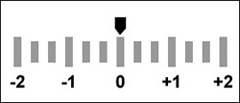Okay, do you have it? Now you are going to get your camera off auto and switch it to manual. There should be a knob on top you can set at "M".
Something like this
Okay first why do you want to do this? Digital cameras are pretty advanced and pretty smart. But they aren't that smart. There are a lot of situations where the camera will choose to take a picture one way when you would choose another. Also you really want to stop using your flash. The flash that is on your camera makes pictures look bad. Really. Don't use the flash.
To shoot in manual you need to understand the exposure triangle - iso, aperture, and shutter speed.
1. ISO - the iso is a measure of how sensitive to light your sensor is. The lower the ISO the crisper your pictures will look. Higher ISO give you more "noise" - kind of a grainy look. So why would you ever set your ISO higher if it gives you :noise"? Well, sometimes you just don't have enough light and the only option is to increase your ISO. Sometimes you can reduce the appearance of noise in post processing. Sometimes you can make the noise look artistic...
2. Aperture - this is how big the opening is that lets light into your camera. The smaller the number the bigger the whole. (Confusing right?) The range of aperture you can get depend on what lens you have on your camera. Right now I have a 50mm 1.8 on my camera. So 1.8 is the lowest (or biggest whole) I can get. 22 is the smallest whole. The aperture affects your depth of field. This is how much of your picture will be in focus. Right now for portraits it is really en vogue to shoot at a low aperture (wide open) to get just the person or part of the person in focus and everything else blurry in the background. That is what they call bokeh.
3. Shutter Speed - is how long the shutter is open - the longer it is open the more light comes in. If you are shooting moving subjects (like kids) you want to have a faster shutter speed to freeze motion and get in focus pictures. Sometimes your own body shaking can cause your picture to get out of focus. So you want to set your shutter speed fast enough to compensate for that. I never shoot below 1/60 if I am hand holding my camera. But I am finding that I really need to shoot faster than that most of the time - especially with my kids.
How they all work together.
1. Decide what is most important to you in your scene. Do you need a fast shutter speed? Set it where you think you need it. Do you want a lot of bokeh? - select a low number aperture. Are you shooting a big group of people? - you probably want a higher aperture - so you can get more people in focus (we will go over this more later, too.) Set your ISO as low as you can.
2.You are going to look through your viewfinder and press the shutter half way down. This will let you know your exposure. You will see something that looks like this:
You want your arrow pointed towards the 0 or maybe towards +1 (but we will go over that later).
2. Okay so say you don't have enough light (your arrow is on the negative side). You have some choices. You can
a. increase your iso
b. decrease shutter speed
c. pick a wider aperture (lower number)
But say you can't have any lower shutter speed because then you will get camera shake or you don't want a wider aperture because you are worried about people being out of focus. So you would have to increase your ISO. It is all about trade-offs.
Okay, so that is it for now. So for the next few days, play around with your camera in manual mode. See how the exposure triangle works together. let me know if you have any questions and post any pictures that you take on our flickr site.
Make sure to include your shooting info - shutter speed, iso, aperture (or also called F-Stop), type of camera and lens.
**I just want to state that when you first start shooting in manual, most likely your pictures will not look as good. Just breathe. Learning how to take good pictures takes time.
**I just want to state that when you first start shooting in manual, most likely your pictures will not look as good. Just breathe. Learning how to take good pictures takes time.






